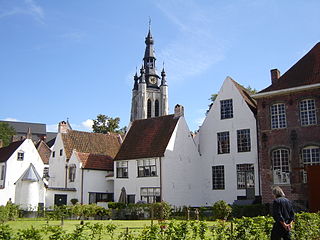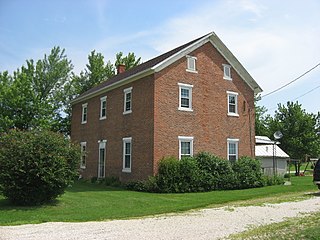Related Research Articles

A cooperative is "an autonomous association of persons united voluntarily to meet their common economic, social and cultural needs and aspirations through a jointly owned and democratically-controlled enterprise". Cooperatives are democratically controlled by their members, with each member having one vote in electing the board of directors. They differ from collectives in that they are generally built from the bottom-up, rather than the top-down. Cooperatives may include:

Hyde Park is the 41st of the 77 community areas of Chicago. It is located on the South Side, near the shore of Lake Michigan 7 miles (11 km) south of the Loop.

An intentional community is a voluntary residential community which is designed to have a high degree of social cohesion and teamwork. The members of an intentional community typically hold a common social, political, religious, or spiritual vision, and typically share responsibilities and property. This way of life is sometimes characterized as an "alternative lifestyle". Intentional communities can be seen as social experiments or communal experiments. The multitude of intentional communities includes collective households, cohousing communities, coliving, ecovillages, monasteries, survivalist retreats, kibbutzim, Hutterites, ashrams, and housing cooperatives.
A worker cooperative is a cooperative owned and self-managed by its workers. This control may mean a firm where every worker-owner participates in decision-making in a democratic fashion, or it may refer to one in which management is elected by every worker-owner who each have one vote.

A beguinage, from the French term béguinage, is an architectural complex which was created to house beguines: lay religious women who lived in community without taking vows or retiring from the world.
The Berkeley Student Cooperative (BSC) is a student housing cooperative serving primarily UC Berkeley students, but open to any full-time post-secondary student. The BSC houses and/or feeds over 1,300 students in 17 houses and three apartment buildings. Food is provided to residents of the 17 houses, which also offer boarding meal plans to non-residents. As part of their rental agreement, residents of the houses are required to perform workshifts, typically five hours per week. The BSC is led by a board of directors which is primarily composed of and elected by student members.

The Community of St John Baptist (CSJB), also known as the Sisters of Mercy, or formerly Clewer Sisters, is an Anglican religious order of Augustinian nuns.
A student housing cooperative, also known as co-operative housing, is a housing cooperative for student members. Members live in alternative cooperative housing that they personally own and maintain. These houses are designed to lower housing costs while providing an educational and community environment for students to live and grow in. They are, in general, nonprofit, communal, and self-governing, with students pooling their monetary and personal resources to create a community style home. Many student housing cooperatives share operation and governing of the house. As with most cooperatives, student housing coops follow the Rochdale Principles and promote collaboration and community work done by the members for mutual benefit.

The Chapungu Sculpture Park is a renowned cultural landmark and sculpture garden in Msasa, Harare, Zimbabwe, which displays the work of Zimbabwean stone sculptors. Spanning over 15 acres of landscaped gardens, the park is dedicated to showcasing the rich heritage of African stone sculpture.
The Order of St. Anne (OSA) is an Anglican religious order of nuns founded in 1910 by the Rev. Frederick Cecil Powell, a member of the Society of St. John the Evangelist, and by its first member and superior Etheldred Barry at Arlington Heights, Massachusetts.

The Cold Stone Creamery, Inc. is an American international ice cream parlor chain. Headquartered in Scottsdale, Arizona, the company is owned and operated by Kahala Brands. The company's main product is premium ice cream made with approximately 12–14% butterfat, made on location and customized for patrons at time of order. Cold Stone has also expanded its menu with other ice cream-related products, including: ice cream cakes, pies, cookie sandwiches, smoothies, shakes, and iced or blended coffee drinks.

The Gruenwald Convent is a historic former Roman Catholic convent in the far western part of the U.S. state of Ohio. Located approximately 0.5 miles (0.80 km) south of the small community of Cassella in Mercer County, the convent was built in 1854. It is one of six convents that were built by the Missionaries of the Precious Blood in this portion of Ohio and in adjacent portions of far eastern Indiana, and one of only two that remain without significant alterations.

The Nativity of the Blessed Virgin Mary Catholic Church is a historic Catholic church in Cassella, an unincorporated community in Mercer County, Ohio, United States. One of several Catholic churches in Marion Township, it has been designated a historic site because of its well-preserved nineteenth-century architecture.

Immaculate Conception Catholic Church is a parish of the Roman Catholic Church in Celina, Ohio, United States. Founded later than many other Catholic parishes in the heavily Catholic region of western Ohio, it owns a complex of buildings constructed in the early 20th century that have been designated historic sites because of their architecture. Leading among them is its massive church, built in the Romanesque Revival style just 43 years after the first Catholic moved into the city: it has been called northwestern Ohio's grandest church building.

The Ida B. Wells Homes, which also comprised the Clarence Darrow Homes and Madden Park Homes, was a Chicago Housing Authority (CHA) public housing project located in the heart of the Bronzeville neighborhood on the South Side of Chicago, Illinois. It was bordered by 35th Street to the north, Pershing Road to the south, Cottage Grove Avenue to the east, and Martin Luther King Drive to the west. The Ida B. Wells Homes consisted of rowhouses, mid-rises, and high-rise apartment buildings, first constructed 1939 to 1941 to house African American tenants. They were closed and demolished beginning in 2002 and ending in 2011.
York Center is an unincorporated community in York Township, DuPage County, Illinois, United States. York Center is located by Meyers Road and 16th Street, near the southern border of Lombard, and the western border of Oakbrook Terrace. York Center has an elementary school, established in 1958, and a fire protection district, which covers unincorporated areas of Lombard, Villa Park, Oak Brook, and Oakbrook Terrace.

Collective farming and communal farming are various types of "agricultural production in which multiple farmers run their holdings as a joint enterprise". There are two broad types of communal farms: agricultural cooperatives, in which member-owners jointly engage in farming activities as a collective; and state farms, which are owned and directly run by a centralized government. The process by which farmland is aggregated is called collectivization. In some countries, there have been both state-run and cooperative-run variants. For example, the Soviet Union had both kolkhozy and sovkhozy.
Frenchtown is an unincorporated community in Seneca County, in the U.S. state of Ohio.
Vina Fields was an African American brothel madam who operated in Chicago from the 1870s to the 1910s. Her career began during the 1870s, when she established her brothel, House of Pleasure, in the Levee District of Chicago. In 1893, at the height of her 30-year career, she owned the largest brothel in Chicago, housing and managing 60-70 women. This made her one of Chicago's wealthiest African Americans and one of the 50 wealthiest people in all of Chicago.
References
- ↑ Manier, Jeremy (November 9, 1997). "Former Convent Takes On Diverse New Life". Chicago Tribune (Chicago, IL)
- ↑ Patel, Eboo (September 15, 2010). The Story of an American Muslim, in the Struggle for the Soul of a Generation. Beacon Press. ISBN 9780807006313.
- ↑ Chicago Community Loan Find 2009/2010 Annual Report